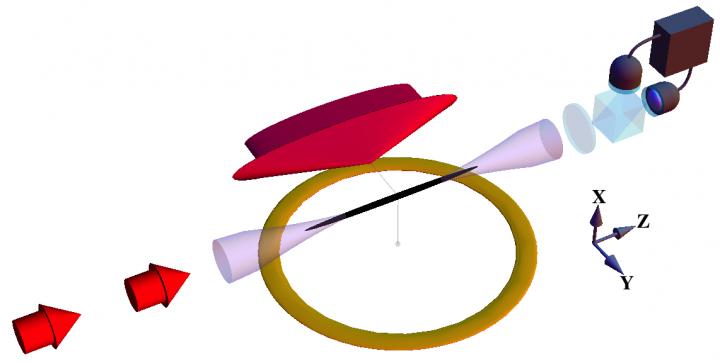Detecting radio waves with entangled atoms

Schematic illustration of the experimental setup. Credit: ICFO
In a study published in Physics Review Letters, and highlighted by APS Physics, ICFO researchers demonstrate a new technique for the coherent the detection of radio frequency magnetic fields using an atomic magnetometer. They use highly sensitive, nondestructive measurements to entangle the atoms, while maintaining their collective coherence, and a new technique to allow the coherent buildup of signal from arbitrarily shaped waveforms.
In this study, ICFO researchers Ferran Martin Ciurana, Dr. Giorgio Colangelo, Dr. Rob Sewell, led by ICREA Prof. at ICFO Morgan Mitchell, trap an ensemble of more than a million rubidium atoms which have been laser-cooled to 16 ?K, close to absolute zero. They apply a static magnetic field to the trapped atoms, so that the atomic spins precess (rotate) synchronously (coherently) at a precise frequency of 42.2 kHz, within the low frequency band used for AM radio broadcasting. They then apply a weak resonant radio frequency field in an orthogonal direction, which perturbs the atomic spin precession – this is the signal they want to detect.
In a standard rf magnetometer, the atomic spins are allowed to evolve freely for some time under the influence of this perturbation to allow the coherent buildup of signal, before the change in the atomic state is detected. Typically, this technique is only sensitive to an rf field applied at a fixed resonant frequency.
In this study, the authors use two techniques to improve their measurement. First, they use stroboscopic quantum non-demolition measurements to prepare an entangled atomic spin state at the start of the detection sequence. This allows them to reduce the quantum noise coming from the atoms, and improve the sensitivity of the magnetometer beyond the standard quantum limit.
Second, they use a new technique developed in the group to allow the coherent detection of an rf field with a changing frequency – as is used, for example, in an FM radio broadcast. During the free evolution time, they use the applied static magnetic field to continuously shift the resonance frequency of the atoms to match the changing frequency of the rf field. This allows the atoms to coherently build up signal from a single arbitrary rf waveform, while blocking unwanted signals from orthogonal waveforms.
They then detect the perturbed atoms using a second stroboscopic quantum non-demolition measurement in order to measure the signal due to the rf field, and verify the entanglement generated among the atomic spins.
The researchers demonstrated their technique by detecting a linearly chirped rf field with a sensitivity beyond the standard quantum limit. They were able to measure the weak rf magnetic-field signal with a 25% reduction in experimental noise due to the quantum entanglement of the atoms, and a sensitivity comparable to the best rf magnetometers used to date.
The technique may have applications ranging from the detection of bio-magnetic fields, and characterization of micro-electronics, to searches for extra-terrestrial civilizations.
###
ABOUT ICFO:
ICFO – The Institute of Photonic Sciences, member of The Barcelona Institute of Science and Technology, is a research center located in a specially designed, 14.000 m2-building situated in the Mediterranean Technology Park in the metropolitan area of Barcelona. It currently hosts 400 people, including research group leaders, post-doctoral researchers, PhD students, research engineers, and staff. ICFOnians are organized in 27 research groups working in 60 state-of-the-art research laboratories, equipped with the latest experimental facilities and supported by a range of cutting-edge facilities for nanofabrication, characterization, imaging and engineering.
The Severo Ochoa distinction awarded by the Ministry of Science and Innovation, as well as 14 ICREA Professorships, 25 European Research Council grants and 6 Fundació Cellex Barcelona Nest Fellowships, demonstrate the centre's dedication to research excellence, as does the institute's consistent appearance in top worldwide positions in international rankings. From an industrial standpoint, ICFO participates actively in the European Technological Platform Photonics21 and is also very proactive in fostering entrepreneurial activities and spin-off creation. The center participates in incubator activities and seeks to attract venture capital investment. ICFO hosts an active Corporate Liaison Program that aims at creating collaborations and links between industry and ICFO researchers. To date, ICFO has created 5 successful start-up companies.
LINKS:
Link to the paper: https:/
APS Physics highlight: https:/
Link to the research group led by ICREA Prof. at ICFO Morgan Mitchell: https:/
Media Contact
All latest news from the category: Physics and Astronomy
This area deals with the fundamental laws and building blocks of nature and how they interact, the properties and the behavior of matter, and research into space and time and their structures.
innovations-report provides in-depth reports and articles on subjects such as astrophysics, laser technologies, nuclear, quantum, particle and solid-state physics, nanotechnologies, planetary research and findings (Mars, Venus) and developments related to the Hubble Telescope.
Newest articles

A ‘language’ for ML models to predict nanopore properties
A large number of 2D materials like graphene can have nanopores – small holes formed by missing atoms through which foreign substances can pass. The properties of these nanopores dictate many…

Clinically validated, wearable ultrasound patch
… for continuous blood pressure monitoring. A team of researchers at the University of California San Diego has developed a new and improved wearable ultrasound patch for continuous and noninvasive…

A new puzzle piece for string theory research
Dr. Ksenia Fedosova from the Cluster of Excellence Mathematics Münster, along with an international research team, has proven a conjecture in string theory that physicists had proposed regarding certain equations….



